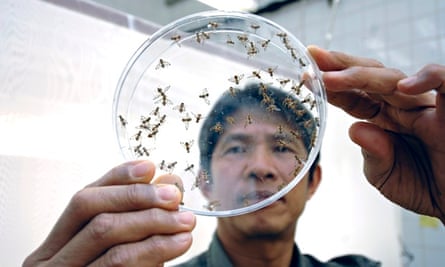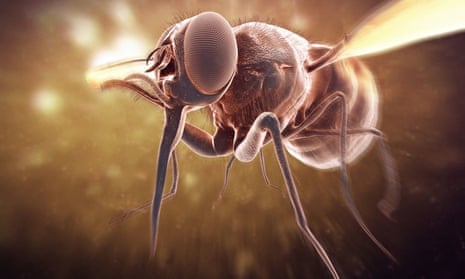From the Sahara to the Kalahari, the tsetse fly has plagued African farmers for centuries. Dating back to prehistoric times, this tiny insect – just eight to 17 mm long – has prevented farmers from using domestic animals to work the land, limiting production, yields and income. The economic impact of the tsetse fly on Africa has been estimated to be as much as $4.5bn. But a simple dose of radiation castration is helping to eradicate the pests in small pockets, enabling farmers to bring animals back into agriculture.
When tsetse flies bite, the parasites (trypanosomes) transferred cause sleeping sickness in humans, and nagana (animal African trypanosomiasis) in animals – mostly cows, horses, donkeys and pigs. The parasites cause confusion, sensory disturbances and poor coordination in humans, and fever, weakness and anemia in animals. Both can be fatal if left untreated.
“In areas with tsetse, people tend not to use intensive forms of agriculture where you use animals or manure on the fields,” says Marcella Alsan, assistant professor of medicine at Stanford University who has researched the tsetse fly’s impact on development. Farmers in these areas use slash and burn agriculture instead but “the issue with that strategy is that you can’t constantly use the land in the production cycle, so it supports fewer people,” says Alsan.
Until now, insecticides have been used to prevent animal trypanosomiasis but this will not eradicate the fly; it reduces numbers but they always come back. Infected animals are treated with trypanocides but these drugs can be expensive, parasites are increasingly developing resistance to them, and in some cases up to 70% of trypanocides sold in Africa are counterfeit or fake (pdf).
But now scientists are hoping that a small dose of sterilisation could contribute to a more permanent and environmentally-friendly end to Africa’s oldest development problem.
The procedure is unusual and fairly slow to work. Wild tsetse flies are captured from a target population and used to mass-rear pupae in factories. The male pupae are separated from the females, put into canisters, and subjected to doses of radiation to make them sterile. The sterilised males are then released by plane (roughly once a week, 100 flies per sq km) to mate with wild females. As a female tsetse fly only mates a few times in her life – once in most cases – any sexual activity with a sterilised male means that female will never produce any offspring. It’s a slow process of birth control, reducing tsetse fly numbers generation by generation.

The upside is that, unlike pesticides, flies cannot develop resistance to this procedure – the sterile insect technique (SIT) – and eradication is sustainable as whole tsetse populations are permanently eliminated. The downside is that the process is slow, expensive and can currently only be used against isolated tsetse populations.
Sterilising insects is a growing industry. The technique is also used against various species of fruit fly, moth, and screwworm fly and there are mass-rearing facilities for these insects around the world, producing hundreds of millions of sterile males per week.
Sterile tsetse flies, however, are so far only produced on a much smaller scale in Burkina Faso, Ethiopia and Tanzania. “This is the major bottleneck to rapidly expanding the use of the SIT on a larger scale against some selected tsetse populations,” says Jorge Hendrichs, head of insect pest control for a programme run by the Food and Agriculture Organisation (FAO) and the International Atomic Energy Agency (IAEA). “Due to the slow reproduction rate of tsetse females it takes a big colony to produce a relatively small output of sterile males.”
On Zanzibar, the tsetse population of Glossina austeni was eradicated by the SIT in 1997, with a major positive socio-economic impact. On Unguja Island, part of the Zanzibar archipelago, the number of small farmers holding indigenous cattle increased from 31% in 1985 to 94% in 2002, and the average income in farming households increased by 30% from 1999 to 2002.
In the Niayes region of Senegal an isolated tsetse population of Glossina palpalis gambiensis is now being successfully targeted but the SIT cannot, unfortunately, get rid of these flies across Africa once and for all.
“Major tsetse eradication campaigns [integrating various methods including the SIT] would stretch over many decades and would require billions,” says Hendrichs. “At the moment, such funding is simply not available. A campaign would require the backing of major international donors to approach the funding levels necessary to begin thinking about such an undertaking.”
In addition, says Hendrichs, total eradication of tsetse is not actually needed as only six or seven of the 32 known species and subspecies attack livestock, and aerial spraying of insecticides can eradicate populations in areas of sparse vegetation.
But for those areas where tsetse populations can be eradicated the benefits are huge. Farmers wouldn’t need to shell out for expensive insecticides or trypanocides and they would finally be able to adopt modern husbandry methods and use animals in the fields to increase crop production. “They would also be able to create small agro-industries – making things like milk and yoghurt to sell for an extra source of income,” says Hendrichs. “This of course leads to higher production output and more money for their families.”
Join our community of development professionals and humanitarians. Follow @GuardianGDP on Twitter.

Comments (…)
Sign in or create your Guardian account to join the discussion